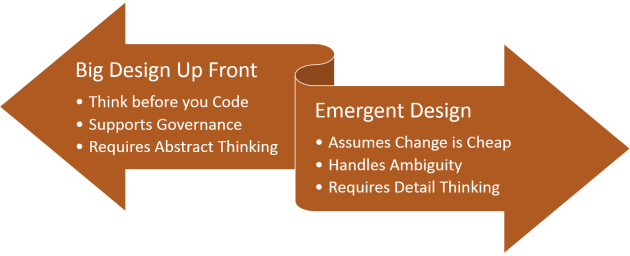 (This post is in response to Hayim Makabee’s posts on emergent design and adaptable design along with some of the follow-up discussions, such as the thread in the “97 Things Every Software Architect Should Know” Linkedin Group and Gene Hughson’s post on emergence vs evolution.)
(This post is in response to Hayim Makabee’s posts on emergent design and adaptable design along with some of the follow-up discussions, such as the thread in the “97 Things Every Software Architect Should Know” Linkedin Group and Gene Hughson’s post on emergence vs evolution.)
One argument software architects regularly encounter is that time spent designing systems is wasted. Many say that “big design up front” is not the agile way and “emergent design” is more effective. This cuts straight to the value proposition of an architect. If up front design has no place in the Agile world, are architects redundant?
To most people, “big design up front” (BDUF), sometimes called “big up front design” (BUFD), means a lengthy, detailed design created at the start of a project. It works on three assumptions. First, one can create requirements for a project. Second, one can create a design to meet those requirements. Third, the design’s suitability for meeting the requirements can be evaluated without implementing it. In other words, there can be good designs and bad designs.
Meanwhile, emergent design means minimal or no design up front (NDUF). It works on the assumption both the requirements and design must be deduced so the team starts developing the product and iterates as they learn more about the problem and the solution. The process finishes at a predetermined time or when “good enough” requirements and design “emerge”.
By inference, emergent design assumes designs are often highly problem/solution specific. Adapting existing designs may create more work than they save. It also moves the focus from providing value to following the design.
Emergent design is quite popular among Agile and Lean practitioners. They argue emergent design reduces some waste (unnecessary work) by not creating lengthy documents that people may never read. Of the read design documents, few are updated as changes are made. Many developers are so cynical they refuse to read documentation and jump straight to the code to answer questions.
Big design up front may encourage over design. Unnecessary features may be added (violating the YAGNI principle) or the system may be unnecessarily complex (violating the KISS principal). Emergent design, particularly when coupled with Test Driven Design (TDD), can produce the minimum code required to meet a requirement and no more.
Big design up front may create an illusion the team knows more than they do. This may prompt decisions when the team knows the least about the problem, meaning big design up front can become big commitment up front. Meanwhile, a team that delays making decisions until necessary may discover different features are needed.
Big design up front’s assumptions are also not always true. Every project has a goal but it may not be clear how to get there. Most startups do not have quantifiable requirements, for example, where coding is more experimenting than implementing. New technologies may supersede old techniques or require new ones, meaning designs are either too difficult to create or cannot be evaluated without implementation.
However, proponents of big design up front point out that designing is often more useful than design documents. The design exercise validates and challenges requirements, explores edge cases and discovers mistakes. Without it, developers often dive straight into low level details and even a short time thinking about the problem can expose assumptions or alternate solutions they would otherwise miss.
Emergent design assumes change is cheap. A lot of effort and attention has been directed to this. Continuous integration and continuous delivery aim to make releasing easy. Test Driven Design (TDD) and automated testing aim to find regressions quickly. Agile methodologies like Scrum provide visibility and guidance on how to manage change.
However, not every change is cheap. Hardware can be difficult or impossible to change once manufactured. Network infrastructure changes need to be scheduled to minimize impact to others. Engaging external vendors may require lengthy contract negotiations. Legacy code may lack sufficient automated unit test coverage. Aspects like security, compliance and scalability are difficult to retrofit.
Similarly, software development must be accountable to the organization. Required skills and teams must be hired or contracted. Budgets must be determined. Progress is usually tracked against milestones and must be approved based on return on investment (ROI) estimations. Risks must be identified and mitigated. Early designs (as part of architectures) can help drive all of this.
Designs present abstracted views of the system, emphasizing important decisions and removing noise. This means designs can also be reviewed by others before the more expensive and time consuming implementation to find weaknesses or suggest improvements. Designs of notable projects can teach others, either by following or avoiding them.
The problem with comparing big design up front against emergent design is it usually devolves into straw man arguments. Neither are absolutes. Good big design up front recognizes some design and details are filled in during development. Good emergent design must start with some idea of how the system will work.
Both big design up front and emergent design can be done badly. Poor big design up front can miss important factors, provide a poor solution or communicate good ideas badly. Poor emergent design can waste time rewriting code, introduce regressions and impede governance. Both can create a big ball of mud. However, big design up front need not be change averse. Emergent design need not be chaotic and unpredictable.
Big design up front and emergent design are process agnostic. Big design up front originated in waterfall processes. As mentioned above, emergent design is common with agile development methodologies. However, emergent design can be used within a waterfall design phase (prototyping) or for defined components during development (spikes). A team using agile development methodologies may do some design inside, outside or between iterations.
Both approaches can be combined. For example, adaptable design is a technique where parts of the system that anticipate change, such as unknown or changing requirements, are designed to accommodate them.
Looking at the comparison from a different angle, what does “design” mean? Is it thinking about how to approach the system or is it documenting and communicating it? A small system may be something a developer can completely understand and describe in a few sentences. It has an implicit, undocumented design and can be iterated over time using emergent design. However, a large or complex system using a mix of legacy and new components whose development is split across different teams may need a different approach. In other words, the benefit of up front design increases as the system complexity increases.
Different approaches require different skills. Big design up front requires thinking about a system in abstract terms. It is skill that not every developer has, requiring breadth rather than depth, and is often why democratizing design fails. By contrast, emergent design embraces a detail and code focus, particularly with the focus on unit testing and small, incremental changes. This is one reason emergent design is more attractive to software developers.
Both big design up front and emergent design are tools a software development team can use. Rather than being excluded, software architects are in a unique position. They can help determine which approach is best for a situation. The real challenge for a software architect is knowing the right amount of design for a system and when to do it.



 (This post is in response to Hayim Makabee’s posts on
(This post is in response to Hayim Makabee’s posts on 